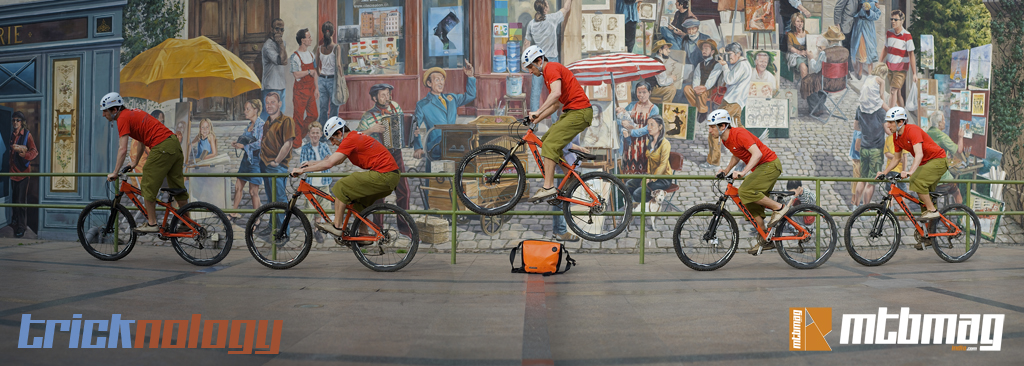Text: Simon Grimmer
Simon Grimmer is a New Zealand born rider who has ridden for as long as he can remember. He rides a bomb proof Kona “Cowan” which he has built up from just a frame. In NZ, he rides trails and competes at local bike parks and enjoys hitting ‘north-shore’ style ramps, beams, bums and ramp combinations that always test the balance, skill and nerve. He is currently living in Shanghai, China. “In a city like this, you to find riding alternatives to forests and dirt with in the cityscape, which is what free riding is all about”. Last year, Simon competed in debut 2-day downhill tournament on his hard tail free-ride bike and won it outright showing that riding ability is still more important than the amount of travel you have.
How to do..
The bunny-hop, like the ollie for skateboarding or a bottom turn in surfing is the fundamental move for free riding. It is essential for anyone wanting to get up a set of stairs, over a curb or onto a bench. You need a ‘hop’ in order to clear a gap, and a flatland 180 or the extra height off a kicker wouldn’t be possible without it. It’s hard to jump an imaginary obstacle. If there is nothing in the way of your bike, it’s hard to get any decent air at all. Any free rider needs to be prepared to clear all manner of obstacles so find an authentic obstacle (even a stick will do) and a bit of clear ground to practice.
Speed and confidence are the key. If you hesitate or break your concentration flow, you’ll never clear the obstacle in your path.
Looking beyond the obstacle and instead focusing on it can be a way to show this confidence. It tells your brain that you are already looking ahead for the next challenge.
Getting up
Once you’ve sized up the terrain, attack the obstacle slowly (speed can increase once you become more proficient) Lean back and straighten your arms and legs. Pull the bike up with your arms by using the momentum you get from shifting your center of gravity back across the bike. Use your arms to pull your bike the rest of the way up and then "pedal" to lift the bike up.
In the air
Shift your weight forward quickly, but not so quickly that you "throw" yourself forward as this will mess with your balance. Try to keep the bike level in the air as when you eventually start bunny-hopping higher obstacles or bigger gaps, you will need this form.
Coming down
Front wheel landings are ugly and can be messy. get your rear wheel down first. It also stabilizes your landing and makes controlling the bike easier. Absorb the impact of your back wheel with your body and roll away or set up for the next trick. Shout!
Practice bunny-hopping over a range obstacles, increase the height or distance of the gap. You have to be able to adapt this skill to all different obstacles and kinds of free ride terrain.
How to do..
The bunny-hop, like the ollie for skateboarding or a bottom turn in surfing is the fundamental move for free riding. It is essential for anyone wanting to get up a set of stairs, over a curb or onto a bench. You need a ‘hop’ in order to clear a gap, and a flatland 180 or the extra height off a kicker wouldn’t be possible without it. It’s hard to jump an imaginary obstacle. If there is nothing in the way of your bike, it’s hard to get any decent air at all. Any free rider needs to be prepared to clear all manner of obstacles so find an authentic obstacle (even a stick will do) and a bit of clear ground to practice.
Speed and confidence are the key. If you hesitate or break your concentration flow, you’ll never clear the obstacle in your path.
Looking beyond the obstacle and instead focusing on it can be a way to show this confidence. It tells your brain that you are already looking ahead for the next challenge.
Getting up
Once you’ve sized up the terrain, attack the obstacle slowly (speed can increase once you become more proficient) Lean back and straighten your arms and legs. Pull the bike up with your arms by using the momentum you get from shifting your center of gravity back across the bike. Use your arms to pull your bike the rest of the way up and then "pedal" to lift the bike up.
In the air
Shift your weight forward quickly, but not so quickly that you "throw" yourself forward as this will mess with your balance. Try to keep the bike level in the air as when you eventually start bunny-hopping higher obstacles or bigger gaps, you will need this form.
Coming down
Front wheel landings are ugly and can be messy. get your rear wheel down first. It also stabilizes your landing and makes controlling the bike easier. Absorb the impact of your back wheel with your body and roll away or set up for the next trick. Shout!
Practice bunny-hopping over a range obstacles, increase the height or distance of the gap. You have to be able to adapt this skill to all different obstacles and kinds of free ride terrain.

